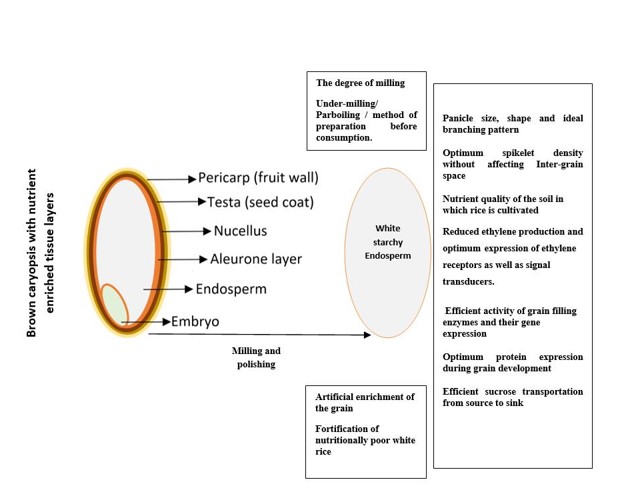Top Links
Journal of Nutrition and Health Sciences
ISSN: 2393-9060
Rice Caryopsis - Its Nutritive Value and Medicinal Properties
Copyright: © 2023 Ajanta Nayak. This is an open-access article distributed under the terms of the Creative Commons Attribution License, which permits unrestricted use, distribution, and reproduction in any medium, provided the original author and source are credited.
Related article at Pubmed, Google Scholar
Cereal crops like rice provides food and sustain health in animal consumers. Its edible caryopsis besides being a source of energy also act as the main nutritional foundation especially for mankind. This paper reviewed the structural complexity of caryopsis, distribution pattern of various nutrients present and their medicinal properties. The caryopsis layers are rich in carbohydrates, proteins, amino acids, lipids, minerals, vitamins, dietary fiber and bioactive compounds. But industrial milling removes most of these nutrient components as polished white rice is mostly consumed. Dismal grain filling process and gradual decreasing of nutrients in grains of many rice cultivars are other factors which further worsen grain quality and deprive poor consumers from getting adequate nutritive value. It results in micronutrient deficiencies, malnutrition and chronic diseases which seriously influence the human health. Therefore, here we have discussed various strategies which will help in mitigating the global health issues. Besides improving human health this review may further help in fulfilling growing demand for quality rice, educating consumers about diet and making them health conscious so that health promoting nutritious brown caryopsis is given more preference rather than the polished endosperm.
Keywords: Rice, Caryopsis, Nutrients, Endosperm, Biofortification
Rice [12] belongs to the class Monocotyledonae, the order Glumiflorae, the family Poaceae, and the genus Oryza. It is one of the important crops for mankind having highest productivities among all cereal plants and is the primary source of food for half of the world’s population [25, 35]. Rice grain is consumed as one of the most dietary sources of carbohydrate, providing energy and nutrients to its consumers, especially to Asian. It provides 21% of global human per capita food calories and 15% of per capita protein [90]. Apart from its nutritional benefits, it possesses medicinal properties too and is a good natural source of various phytochemicals like hydrocarbons, fatty acids, acylglycerols, terpenoids and sterols. These “green” phytochemicals have protective or disease-preventing property thus can help rice consumers stay healthier. They also have numerous applications in industries like pharmaceuticals, nutraceutical, cosmetic, food and chemical, and show various kinds of biological activities, such as antimicrobial, antioxidant, cytotoxic, and anti-inflammatory properties. But consumers do not get all the nutrients as well as medicinal phytochemicals present in rice and are deprived of all benefits as they consume polished white endosperm instead of brown nutrient enriched caryopsis. Therefore, this paper aims to review [1] the structural layers of rice grain in details, [2] the specific nutritional components and their distribution in different parts of caryopsis, [3] their medicinal value for human health. The focus of future research on developing elite cultivars with nutrient dense grains, increasing grain filling efficiency in a panicle, alleviating the nutritional loss by adopting appropriate milling process and fortification approaches are also discussed. This review will help in providing food and nutritional security to consumers as well as economic benefit to farmers.
Rice is an annual grass and has round, hollow, jointed stems (culms) which bear unique racemose type inflorescence called panicle. The panicle is chlorophyllous and bears spikelets for storage of photosynthetic product [15]. A matured rice grain is produced only when the spikelets undergo the process of cell division, differentiation and starch biosynthesis during the course of development. This vital organ for yield consists of an outer structure, the hull and the fruit called caryopsis (brown rice). The hull is a tough covering which wrap the inner caryopsis. The woody and abrasive structure constitutes about 20% of the grain weight and is composed of cellulose (50%), lignin (25-30%), silica (15-20%) and moisture (10-15%). Hull is not edible and possesses low nutritive value, therefore they are dehulled or partially hulled from the harvested grain by milling process. Hull removal yields caryopsis with its bran, endosperm and embryo still intact.
Rice caryopsis is simply a single-seeded fruit which serves as a key nutrient storage organ. It is composed of diploid maternal tissues like pericarp (which includes the epicarp, mesocarp and endocarp); testa; nucellus; and filial tissues like triploid endosperm; and diploid embryo. (Figure 1). These tissues are tightly fused together, undergo coordinated physiological interactions which is required for caryopsis development and at maturity all these tissues are dead except the embryo and the aleurone [26, 56]. The pericarp is the three-layered ripened ovary wall which is about 10 µm thick and encloses the seed within it. The pericarp is formed eventually after completion of developmental process, and can be fleshy (guava, mango etc.) or dry (mustard, walnut, etc.). The main role of pericarp is seed protection and being mostly edible it is consumed by animals and birds thus contribute in seed dispersal also. Rice pericarp has three vascular bundles, a major one with well-formed tracheary and sieve elements at the dorsal side and two smaller ones at the lateral sides [26, 74]. The cells located next to the major vascular bundle provide a channel for loading of water, minerals, nutrient and photosynthesis assimilates for the developing filial tissues of the caryopsis [45, 26]. Expression of cell wall invertase gene CIN2/GIF1 in the dorsal bundle also plays critical role to hydrolyze sucrose to fructose and glucose and its mutation leads to poor grain filling [71, 72]. Inner to the fruit wall lies the testa, the “armor” of the seed which provides protection to embryo from mechanical damages and dehydration. This layer is only a few cells in thickness and less fibrous than the pericarp layer. The nucellus is about 2.5 µm thick and located between the testa and endosperm. Generally, it consists of a single crushed layer of empty epidermal cells at maturity. Caryopsis maternal tissues are composed of nine distinct cell types which undergo differentiation and degeneration during the entire process of development. The cells exhibit dynamic changes in their morphology, size, thickening of cell wall and starch accumulation which may facilitate delivery of water and nutrient required for grain filling [73].
The endosperm is a triploid tissue which constitutes 70% of the rough rice weight. It mainly consists of endosperm proper and outermost aleurone layer. The endosperm proper consists of the outer subaleurone tissue and inner starchy endosperm at the center. Aleurone may be two or three layered at the dorsal part whereas it may have a single layer at the ventral side of rice endosperm. But the cell layer may vary from one to several cells thick depending upon the species and position (dorsal, ventral or lateral) in the grain as well as environmental factors. The aleurone layer located between the endosperm and the nucellar epidermis carries out multiple functions. It encloses the starchy endosperm and plays crucial role in the apoplastic uptake of nutrients into it [75], synthesis and release of hydrolases in the endosperm during germination. The layer also gives protection to the endosperm during the grain filling stage, maintains stored starch in it and ensures seed survival [30]. Modified aleurone cells called transfer cells participate in grain filling via solute uptake [56]. A NF-YB1 transcription factor expressed in the dorsal aleurone regulates expressions of three sucrose transporters in the aleurone, allowing sucrose loading in the developing endosperm [3]. Inner to the aleurone layer lies the endosperm which grows and accumulates nutrients continuously. It acts as a nourishing tissue and transfer nutrients from the vegetative tissues to metal rich embryo. Therefore, it aids in formation as well as growth of embryo and may also affect embryo development. Transcriptome study of rice embryo and endosperm has revealed that 1054 genes are predominantly expressed, and 474 genes are differentially expressed in endosperm during development. The other filial tissue is the diploid embryo which occupies a small fraction (2-3%) and is located at the ventral bottom part of the caryopsis. It is mainly composed of the scutellum (conductive tissue) and embryonic axis. The embryo is the most important part of the seed as it can develop into the roots, stems and leaves of plants
Caryopsis is structurally quite complex but each part of the caryopsis houses health-promoting nutrients. The number of nutrient enriched caryopsis layers and size of caryopsis determine the quantities of important phytochemicals and minerals [59]. Therefore, the whole caryopsis is one of the most important nutritious food sources for mankind with immense health benefits
Dehulled rice is composed of dark color outer protective layer called bran which is approximately 10% of the caryopsis weight and includes pericarp, testa and nucellus layers. The bran layer is rich in fibre, fat, oils, vitamins, minerals, antioxidants, protein, free amino acids, sugars and other phytochemicals [68] therefore it is highly nutritious. Its chemical composition consists of 12-17% protein, 13-23% fat, 34-54% carbohydrates, and 6-14% fibre [57]. Bran possesses enormous benefits for human health as it provides 40% of the total minerals, 90% of total phosphorous, 50% of total niacin (Vitamin B3), 50% of total lipid, and 50% of the total phenolic compounds of the whole rice caryopsis [87]. The bran pericarp also produces anthocyanins and proanthocyanidins as in some black- and red-grained varieties of rice [87]. The testa is also rich in oil and protein but its starch content is very low. The nutritious and high-fat containing oil from the bran layer is extracted for use in cooking, as a salad oil/cooking oil. The extracted “healthy oil” is in demand owing to its consumer-friendly properties like health benefits, fatty acid balance, high smoking temperature, and oxidative stability [14, 33]. The oils fatty acid composition is approximately 20 % palmitic, 35 % oleic and 40 % linoleic acids with small amounts of other fatty acids. It also contains bioactive phytochemicals like gamma-oryzanol, tocopherols and tocotrienols (Vitamin E) [46]. The bran proteins are richer in albumin and are found as distinct protein bodies which are structurally different from endosperm protein bodies. The bran albumin and globulin proteins are also bound to amino acids. The outer bran layer contains lipids (triglycerides) and most of the lipids accumulate in the form of oil bodies. The amount of lipid found in bran is relatively high and the main lipids are oleic and linoleic acids. Alpha linoleic acid and saturated fatty acids like palmitic and stearic acids as well as policosanols, saponins and phytosterols are also found in the bran. Nutrients like iron, zinc and fat- soluble vitamin A is also present in the outer bran layer. Trace amount (0.2 ppm) of β carotene is also present in this layer but colored rice bran is a rich reserve of β carotene. Defatted bran is also a chief source of valuable protein for food industry [55]. The bran layers also play vital role in cooking behaviour of the rice grain [73].
Endosperm development is closely related to grain yield and quality [84]. It also plays an important role in determining the nutritional value of rice through its nutritive component like starch, protein, lipids, fibre, small amounts of vit B and minerals. The endosperm aleurone-subaleurone layer has immense importance for human nutrition and seed development. The subaleurone tissue consists of four to six layers which are poor in starch content but accumulate storage proteins, especially glutelins and prolamins [30]. The aleurone layer also harbor spectrums of micronutrients like lipid, protein, minerals, vitamins, fibers and antioxidants [1] and is very rich in phosphorous, magnesium, and potassium. The aleurone layers are composed of quadrangular parenchyma cells and may be generally monolayered (wheat) or multi-layered (rice, barley and oats) [5]. The number of aleurone layers determines the amount of micronutrients like iron and zinc in rice [59]. The cells of aleurone contains mostly protein bodies and lipid bodies. [65] Reported the presence of 66 % albumin, 7 % globulin and 27 % prolamin plus glutelin in aleurone protein bodies. Aleurone layer also slightly affects cooking quality but its effect on rice texture and peak viscosity is remarkable [74].
Starch is the chief storage form of carbohydrate in all green plants including rice. The plant assembles extra simple sugar called glucose into a renewable polysaccharide called starch. About five hundred to several hundred thousand glucose molecules are joined by glycosidic bonds into a single structure which are further organized in a complex semicrystalline structure to form compound granules in the endosperm amyloplast. Amyloplast number and volume increase with the development of caryopsis. [8, 40] The two major components of starch are amylose and amylopectin. Amylose is a linear glucose polymer with a tightly packed structure with lower molecular weight (500–20,000 glucose units). It contains α (1 – 4) linked D-glucopyranosyl units with few (0.1% according to [6]) α (1 - 6) linkages. The long linear amylose chains readily crystallize, therefore high-amylose starch is more resistant to digestion. They are slightly branched with 2–5 chains on average [64] and have a structure intermediate between that of linear amylose and amylopectin and are consequently often referred to as intermediate material [63]. Typical levels of amyloses in starches are 15-25% [34] but in waxy (wx) rice [54] starches are virtually amylose free. High amylose content in rice leads to poor cooking quality and vice versa [85]. The other component amylopectin is a soluble polysaccharide and highly branched polymer of glucose found in plants and is a major component (70-80%) of starch. Amylopectin consists of α (1 - 4) linked D-glucosyl chains and is highly branched with 5–6% α (1 - 6) bonds [6]. Amylopectin is formed of 2,000 to 200,000 glucose units and its inner chains are formed of 20-24 glucose subunits. It has a compact shape and packed less tightly at the molecular level, providing easier access to digestive enzymes and thus can be broken down and digested more quickly than amylose. The rice starch properties play an important role in determining rice nutrition and cooking quality.
The minor components in starch, which are either at the surface or inside the starch granules are lipids, proteins, amino acids, mineral nutrients and vitamins. Cereal starches contain up to1% lipids and 0.25% proteins [4, 62]. Starch lipids are mainly monoacyl lipids (fatty acids and lysophosphatides) complexed with amylose [10]. The starch lipid content is lowest for waxy starch granules. The protein composition of rice largely determines characteristics like nutritional value, functional properties, the texture and its taste [14]. Rice grains contain easily digestible proteins closely associated with starch granules.
Although rice protein ranks high in nutritional quality among cereals, its protein content is modest but brown (unpolished) rice has more proteins (1%) [26] compared to polished rice. Proteins in endosperm (milled rice) consist of 15 % albumin (water soluble) plus globulin (salt soluble), 5 to 8 % prolamin (alcohol soluble) and the rest glutelin (alkali soluble) [21]. Starch proteins are either (i) storage proteins or (ii) biosynthetic or degradative enzymes [4]. Rice storage proteins exist mainly as protein bodies in endosperm, i.e. large spherical protein bodies (mainly prolamin) or crystalline protein bodies II (mainly glutelin) [43, 53] estimated that endosperm storage proteins were composed of 60 to 65 % protein bodies-II proteins, 20 to 25 % protein bodies-I proteins and 10 to 15 % albumin and globulin in the cytoplasm. Although rice contains less protein than many grains, its biological value is highest due to the balanced composition of amino acids. Amino acids are organic compounds required by all living organisms including plants to make proteins as they act as building blocks. These molecules also act as metabolites/metabolic intermediates, controls growth and development as well as play role in response to stresses. The amino acid composition is associated with the organoleptic characteristics of product and the unique taste characteristic of rice varieties in dishes [23]. Rice caryopsis contains 20 main amino acids, including eight essential amino acids namely Lysine (Lys), threonine (Thr), methionine (Met), tryptophan (Trp), phenylalanine (Phe), isoleucine (Ile), leucine (Leu), and valine (Val). The content of essential amino acids determines the nutritional value of proteins found in grain. Therefore, consumption of cereal crops amino acids serves as important nutrition sources for both humans and animals [79]. In a ripe rice grain, the diet efficacy of amino acids varies greatly within the parts of grain. Grain nutritional value of different rice varieties also varies greatly, due to difference in content of amino acids like aspartic, glutamic, serine, glycine, alanine, leucine, and proline [22]. The protein of rice is rich in glutamic, aspartic acids, alanine and glycine. Lysine content is 3.5 to 4.0 % in rice which is higher than wheat, maize and sorghum and is the main index to judge its nutritional quality [14]. The amino acids may occur as free or in bound forms in a rice grain. Very low (0.35–0.55%) amount of free amino acids occurs and act as substrates of protein synthesis, regulate protein quantity and quality impacting grain appearance and its taste at maturity. Free glutamate (Glu) particularly has role in enhancement of taste quality in rice. The bound form of amino acids is associated with storage proteins like albumin, globulin, prolamin, and glutenin found in different region of a grain. Accordingly, the distributions of amino acids vary with the types of storage proteins. Endosperm contains amino acids bound to prolamin and glutenin. The amino acid content of rice grains may vary among grains located at different positions on the panicle. Grains located in the basal region of a panicle may be poor in amino acid content as they are of inferior quality. Phosphorus is another important noncarbohydrate component of rice starch. In waxy rice starches, it is mainly present as phosphate-monoesters (0.003% on dry basis), whereas non-waxy rice starches predominantly contain phospholipid phosphorus (0.048% on dry basis) [17, 20]. Other mineral components of starch are calcium, potassium, magnesium and sodium in their ionic form.
The fatty embryo is highly nutritious but it is not desirable since it negatively affects rice preservation [48] therefore it is removed by industrial milling which improves shelf life [3] beside providing aesthetic appeal to rice. The by-product possesses nutritional content of 70-80% [45] and is rich in variety of healthy phytochemicals such as tocopherols, tocotrienols, gamma-oryzanol, phytic acids, octacosanol and gamma-aminobutyric acid (GABA). It also contains especially important nutrients such as Lipids, Proteins, vitamin B, dietary fiber and minerals [3]. Lipids are stored in embryo usually as triacylglycerols. Embryos contain 34% of the total triacylglycerols present in rice seeds [30]. These lipids not only serve as energy source for germination and plant growth but also provides health promoting nutritional benefits to humans. [44] reported the presence of 98 % albumin in the embryo protein bodies.
Apart from its nutritional importance, rice caryopsis has medicinal value too. Consumption of whole grain has been shown to be positively correlated with good health. It is used in the treatment of various ailments such as high blood pressure, heart disease, Alzheimer’s disease, skin care, diarrhoea, vomiting, paralysis, rheumatism, leucorrhea, fever, hemorrhage, chest pain, wounds, burns and provides instant energy as well as vitamin B1 to human body [11]. Rice is the main constituent of oral re-hydration solutions (ORS) and certain varieties are used as a health tonic and for lactation, as a body enriching item, to exclude toxins and delay premature ageing etc. Colored rices are rich in minerals and polyphenols and have antioxidant properties. Traditional varieties with low glycemic index are useful as weight-reducing diets. Amino acids found in rice are building material for creating proteins, their deficiency disrupts synthesis of vitamins, pigments, hormones. Consumption of food products with unbalanced amino acids composition weakens cognitive abilities as well as reduces immunity. Relationship with likelihood of diabetes has been established for several amino acids like serine, alanine, arginine.
The lack of Lys, Thr, and Met which are considered as the first, second, and third most restrictive essential amino acids in rice, significantly decrease the absorption as well as utilization of other amino acids resulting in serious humans or animal’s diseases [80]. For example, deficiency of Lys decreases the defense ability of mammalian cells against viruses and also causes osteoporosis and hyperlysinemia in humans. Lack of Met can result in methylation-related disorders such as tumorigenesis, neurological disorders, and atherosclerosis. Insufficient intake of Thr can lead to insanity, dyspepsia, and fatty liver. Studies on animal trials have shown that purified rice endosperm protein have hypocholesterolemic effects. Similarly, the beneficial effects of rice endosperm protein intake in ameliorating lipid dysfunction such as decreasing total cholesterol (TC), low density lipoprotein cholesterol (LDL-C) and triglycerides (TG) has also been demonstrated [18]. Moreover, rice endosperm protein helps in minimizing the progression of diabetic nephropathy in Goto-Kakizaki rats on high-sucrose diet [29]. Rice bran oil has significant effects in reducing blood low-density lipoprotein cholesterol levels [49]. Bran oil and its other components have immune stimulatory effects. Rice bran supplementation enhances gut health, delay Alzheimer’s disease, mitigate menopausal hot flashes, prevent bone loss in older women and prevents or ameliorates various metabolic disorders. Bran phytic acid, δ-tocotrienol, ℽ- tocotrienol and ℽ-oryzanol also has anti-- cancer aspects and inhibit tumor growth as well as proliferation because of antioxidant activity. Thiamin content in caryopsis can prevent beriberi which cause degeneration of cardiovascular system and the nervous system in humans. Thiamine deficiency has been linked to cognitive impairment, dementia and depression [52].
Nutrient enriched rice is the most crucial requirement for betterment of public health in the current malnourished world and can be accomplished broadly in two different ways i.e in the rice plant itself by development of novel varieties and secondly after harvesting by following various strategies. In a rice panicle spikelet development lacks homogeneity and there is considerable variation in individual grain weight as well as their nutritional value. All matured grains are not of optimum quality for human consumption due to variation in filling efficiency. Generally, spikelets reaching anthesis on day one only produces well-filled high-density grains but quality declines successively in other spikelets in a panicle and many of them hardly fill to the hull capacity and also become brittle during milling [37]. These early flowering upper spikelets fill faster compared to those on basal branches because of heterogeneous architecture of panicle which leads to inter-grain apical dominance. Moreover, basal sink organs exhibit slackened filling because of increased compactness of panicle due to accommodating greater number of spikelets especially in the large-panicled new plant type rice derived from the tropical japonica background, in contrast the indica inbred cultivars exhibit higher grain filling [77]. Perhaps higher grain density exacerbates competition for assimilates and basal spikelets becomes disadvantaged and source limited for assimilate partitioning [24]. The grain filling pattern expressed in difference of individual grain weights and quality varies with the architecture of panicle and is unique for a rice genotype. Thus, modifying rice panicle architecture and development of elite cultivars with ideal designer panicle bearing good quality nutrient dense grains with higher filling efficiency will help in decreasing the quality variation among grains simultaneously breaking the yield barrier of rice. Starch accumulation is very poor in the basal grains of the panicle [37, 38] because of poor activity of the starch synthesizing enzymes[19, 25, 32, 67]. Biotechnological manipulation of these enzymes for enhancement of grain yield as well as nutritional quality is of utmost need to feed the growing population and prevent malnutrition. High ethylene production in rice is also detrimental for grain filling. Owing to high ethylene production, activity of starch synthesizing enzymes diminish leading to poor grain formation has been corroborated by several researchers [39, 67, 78, 80, 87]. High level of ethylene also accelerates pericarp (outermost layer of caryopsis rich in nutrients) senescence [40] and retard male gametophyte development [42]. Ethylene also stimulates constitutive expression of ethylene receptors and signal transducers [59].Therefore, reduced ethylene production and optimum expression of ethylene receptors as well as signal transducers in rice will definitely increase quality, yield as well as enhance its nutrient content. The complex process of grain filling involves 21000 genes of which 269 are closely related to the biochemical pathways for different physiological activities [83]. These genes are responsible for control of various activities, such as starch synthesis, hormonal balance; activity of cell cycle regulation and transport and storage of assimilates etc. in the endosperm. The transcription profiles of the genes have been compared between superior and inferior spikelets of rice panicle [83]. DNA microarray and real time PCR analyse have shown higher expression profile for starch synthesizing enzyme genes in superior compared to inferior spikelets.
The genes encoding proteins for cell cycle regulation also express poorly in the inferior spikelets compared to the superior spikelets [12]. Transciptome analyses further revealed differential expression of 189 miRNAs between the two types of spikelets. Proteomics analysis [12, 83] confirmed functional differences in endosperm filling between superior and inferior spikelets.
Abundance of many proteins and phosphoproteins differed resulting in differential grain filling of superior and inferior spikelets because of low starch synthesis, carbon metabolism, cell division, and N-partitioning. Modern molecular approaches should be used to achieve optimum expression of grain filling related genes and grain protein expression irrespective of positional difference. Poor activity of the transporters leading to low concentration of the sucrose in the apoplasmic fluid retards endosperm development [28]. Sugar transporters belong to the major facilitator super family [51] and are essential for the transport of assimilates from autotrophic sources to heterotrophic sinks tissues. Interestingly out of 269 genes preferentially expressed during rice grain ripening, thirty were various transporters [89]. So, in order to ensure proper grain development efficient sucrose transportation to the sink is necessary. Higher rice productivity and nutritional quality can also be achieved through soil quality management where the crop is grown. Nutrient replenishment through application of balanced fertilizer will help in maintaining soil fertility and produce good quality nutritious grain in the rice plant.
After harvesting rice grain is subjected to milling and polishing. The polished white rice lacks significant portion of micronutrients, B-vitamins and crucial minerals such as iron thus it is a very poor source of micronutrients and vitamins [61]. In order to reduce micronutrient malnutrition, the poor/broken rice can be enriched with artificial enrichment or by biofortification (via genetic engineering/ molecular breeding) strategies [70]. Rice is the major calorie supplier since it is cheap and can be grown in different climatic zones thus development of biofortified rice has attracted much attention from breeders and biotechnologists. Rice endosperm can be fortified with micronutrients or phytonutrients using modern technique like Genetic Engineering which has great potential to promote human health and nutrition [62, 68]. Apart from micronutrients, rice can be fortified also with various minerals such as iron, zinc, calcium and vitamins like A and B. Enrichment and fortification helps in restoring the healthy nutrients which are removed due to milling. Nutrition improvement can also be achieved using genome editing (CRISPR/Cas9) technology in near future. Parboiling method also reduces the loss of useful components and helps in increase of fat, vitamin and protein content and can be followed in order to enhance the nutritional value in rice. All these strategies will definitely help in achieving highly nutritious rice grain and enriching polished rice so that rice consumers get maximum health benefits which will save mankind from nutritional disorders and keep them healthy
Rice has been used by mankind since long time ago for its nutritional, medicinal as well as social and cultural importance. Rice caryopsis poses mineral nutrients like iron, zinc and calcium. Additionally, it is a supplementary diet for some of the vitamins like thiamine, niacin, riboflavin and vitamin D. Thus, caryopsis can fulfill the starch, protein and micronutrient requirements of its consumers providing greater health benefits. It will definitely help in eradicating malnutrition, especially in children, women and other weaker section of society who mainly depend on rice. It will not only feed their hungry stomach but will improve their nutritional status as well. Moreover, its phytochemicals will protect human being from diseases and deaths.
But in the present scenario, only endosperm is considered as the chief edible part in rice and is preferred in the polished form. While milling, nutritious embryo and the maternal tissues are removed despite having plenty of nutrients. The caryopsis is polished to ~90% of the original weight turning it to white endosperm which is mostly consumed on a global scale [48, 84] as a good energy diet. The widespread acceptance of polished white endosperm is probably due to more delicate taste, appealing look, easy to cook and chew, better digestibility, change in texture and storage potential. But polished rice has less moisture, mineral, biotin, niacin, protein and fatty contents. Polishing decreases almost all amino acids and also lowers concentrations of free amino acids as well as free sugars (i.e., sucrose and glucose) [69]. Malnutrition in humans and livestock caused by the insufficient intake of amino acids, especially the essential amino acids that could not be produced by de novo biosynthesis, is a serious global problem. Compared with brown rice it is poor in many essential nutrients including dietary fibre, antioxidants etc. since milling removes the nutrient enriched tissue layer. Probably lack of information and knowledge about nutrition, healthy diet, consequences of malnutrition and diseases has resulted in consumption of polished rice. The unpolished whole caryopsis is consumed only in some pockets where people still follow traditional methods of processing and those who are aware about its nutritional and medicinal importance. Being health conscious, these people consume the unattractive brown caryopsis with all its edible layers intact despite having a poor taste due to the high fiber content of the pericarp. Consumption of unpolished rice will not only enrich rice consumers with healthy nutrients but will help in conserving about 43-54 million tonnes rice every year [54].
Gradually micronutrient content of rice seed is declining which greatly influences the nutritional status as well as the health of rice consumers in the developing countries. Especially the children and women suffer from micronutrient deficiency and become prone to chronic diseases [71]. Apart from this decreasing cultivation area, deteriorating climatic conditions and poor grain filling are other factors hampering quality of grain simultaneously decreasing the production. Therefore, novel high yielding varieties with optimum filling efficiency as well as improved health and nutritional benefits should be developed. Cultivation of traditional varieties with nutritional and medicinal importance should be encouraged. Ideal panicle architecture with optimum grain number would definitely improve the filling efficiency as well as the nutritional composition of basal grains. Biotechnological approaches should be used to develop elite cultivars using key traits from traditional varieties which are more nutritious and poses medicinal value. Increasing the content of amino acids, especially Lys and other essential amino acids, in rice grains is of great significance to improve the nutritional and living standards of people in countries where rice is the staple food. Technological advancement is of utmost necessity in order to keep the beneficial property of grain intact, while processing. Under-milling/parboiling/optimized method of preparation should be done in order to protect the nutrients, and they are not lost. Nutrient quality of the soil and its health in which rice is cultivated need to be maintained. Intensive artificial enrichment of the grain as well as rice fortification need to be taken up in future as already this approach has been quite successful. Rice scientists have already produced fortified rice grain with high iron, low phytate, high zinc, high carotenoid (golden rice). Recently two varieties CR Dhan 310 and CR Dhan 311 with higher protein and zinc content respectively has been released by scientists from NRRI, India. Therefore, it is of utmost need to increase the nutritional quality in rice, check nutrient loss, discourage consumption of nutritionally poor polished white rice and increase number of brown rice consumer.
 |
| Figure 1: Schematic diagram representing caryopsis layers and likely strategies for nutrient enrichment |






































